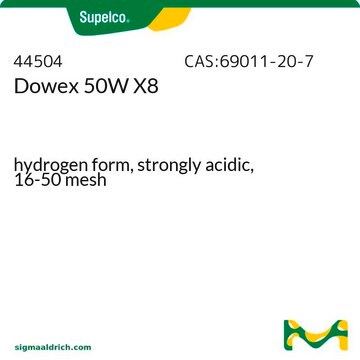240117
1,6-Hexanediol
99%
Sinónimos:
Hexamethylene glycol
Iniciar sesiónpara Ver la Fijación de precios por contrato y de la organización
About This Item
Fórmula lineal:
HO(CH2)6OH
Número de CAS:
Peso molecular:
118.17
Beilstein:
1633461
Número CE:
Número MDL:
Código UNSPSC:
12162002
ID de la sustancia en PubChem:
NACRES:
NA.23
Productos recomendados
presión de vapor
0.53 mmHg ( 20 °C)
Nivel de calidad
Análisis
99%
temp. de autoignición
608 °F
lim. expl.
16 %
bp
250 °C (lit.)
mp
38-42 °C (lit.)
cadena SMILES
OCCCCCCO
InChI
1S/C6H14O2/c7-5-3-1-2-4-6-8/h7-8H,1-6H2
Clave InChI
XXMIOPMDWAUFGU-UHFFFAOYSA-N
¿Está buscando productos similares? Visita Guía de comparación de productos
Descripción general
1,6-hexanediol is a versatile chemical compound commonly used in the polymer industry. It is used as a building block or monomer for the synthesis of various polymers and polymer-based materials. For instance, it can be used in the production of polyesters, polyurethanes, and polyamides, among others. These polymers find applications in a wide range of industries, including automotive, textiles, coatings, adhesives, and sealants.
Aplicación
1,6-Hexanediol can be used for a variety of applications such as:
- a structure-directing agent for the synthesis of ZSM-5 zeolite
- a solvent for titanium tetra-isopropoxide to form titanium oxide (TiO2) nanocrystals
- a phase change material in combination with lauric acid for thermal energy storage applications
Código de clase de almacenamiento
11 - Combustible Solids
Clase de riesgo para el agua (WGK)
WGK 1
Punto de inflamabilidad (°F)
215.6 °F - closed cup
Punto de inflamabilidad (°C)
102 °C - closed cup
Equipo de protección personal
Eyeshields, Gloves, type N95 (US)
Elija entre una de las versiones más recientes:
¿Ya tiene este producto?
Encuentre la documentación para los productos que ha comprado recientemente en la Biblioteca de documentos.
Los clientes también vieron
Microwave-driven polyol method for preparation of TiO2 nanocrystallites
Yamamoto T, et al.
Chemistry Letters (Jpn), 31(10), 964-965 (2002)
Guido van Mierlo et al.
Cell reports, 34(5), 108705-108705 (2021-02-04)
Membraneless organelles are liquid condensates, which form through liquid-liquid phase separation. Recent advances show that phase separation is essential for cellular homeostasis by regulating basic cellular processes, including transcription and signal transduction. The reported number of proteins with the capacity
Giorgio Gaglia et al.
Nature cell biology, 22(2), 151-158 (2020-02-06)
Under proteotoxic stress, some cells survive whereas others die. The mechanisms governing this heterogeneity in cell fate remain unknown. Here we report that condensation and phase transition of heat-shock factor 1 (HSF1), a transcriptional regulator of chaperones1,2, is integral to
H D Durham et al.
Muscle & nerve, 11(2), 160-165 (1988-02-01)
We reported previously that 2,5-hexanedione (2,5-HD), the neurotoxic metabolite of methyl-n-butylketone (MnBK) and n-hexane, induced aggregation of intermediate filaments of the vimentin type in cultured fibroblasts. To determine if these findings have relevance to the mechanism by which these hexacarbons
Sreejith J Nair et al.
Nature structural & molecular biology, 26(3), 193-203 (2019-03-06)
A crucial feature of differentiated cells is the rapid activation of enhancer-driven transcriptional programs in response to signals. The potential contributions of physicochemical properties of enhancer assembly in signaling events remain poorly understood. Here we report that in human breast
Nuestro equipo de científicos tiene experiencia en todas las áreas de investigación: Ciencias de la vida, Ciencia de los materiales, Síntesis química, Cromatografía, Analítica y muchas otras.
Póngase en contacto con el Servicio técnico











